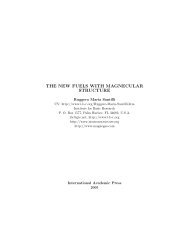brst symmetry in cohomological hamiltonian mechanics - Institute for ...
brst symmetry in cohomological hamiltonian mechanics - Institute for ...
brst symmetry in cohomological hamiltonian mechanics - Institute for ...
You also want an ePaper? Increase the reach of your titles
YUMPU automatically turns print PDFs into web optimized ePapers that Google loves.
Note that <strong>in</strong> the limit β → 0, we recover the classical Po<strong>in</strong>care <strong>in</strong>tegral<br />
<strong>in</strong>variants K p , p = 1, . . . n, as the solutions of Hρ = 0. They are fundamental<br />
BRST <strong>in</strong>variant observables of the theory, {Q, K p } = 0, s<strong>in</strong>ce <strong>in</strong> the untwist<strong>in</strong>g<br />
limit, β → 0, the super<strong>symmetry</strong> generators Q β and ¯Q β become the<br />
BRST and anti-BRST generators, respectively. Geometrically, this follows<br />
from dK p = 0 s<strong>in</strong>ce K p = ω p and dω = 0. Similarly, ¯Kp ’s are anti-BRST<br />
<strong>in</strong>variant observables.<br />
Also, it should be noted that there seems to be no relation of the supersymmetric<br />
Hamilton function H to the Morse theory[13] due to the generic<br />
absence of terms quadratic <strong>in</strong> h i . The reason is that the symplectic two<strong>for</strong>m<br />
ω is closed so that this does not allow one to construct, or obta<strong>in</strong> by<br />
the BRST gauge fix<strong>in</strong>g procedure, non-vanish<strong>in</strong>g terms quadratic <strong>in</strong> fields,<br />
except <strong>for</strong> the ghost-antighost. On the other hand, such terms, which are<br />
natural <strong>in</strong> (<strong>cohomological</strong>) quantum field theories, would produce stochastic<br />
contribution (Gaussian noise) to the equations of motion[19] that would,<br />
clearly, spoil the determ<strong>in</strong>istic character of the Hamiltonian <strong>mechanics</strong>.<br />
3 Correlation functions<br />
Let us now turn to consideration of the correlation functions of the BRST<br />
observables. The BRST <strong>in</strong>variant observables of <strong>in</strong>terest are of the <strong>for</strong>m<br />
O A = A i1···i p<br />
(a)c i1 · · · c ip , which are p-<strong>for</strong>ms on M 2n , A ∈ Λ p . One can easily<br />
f<strong>in</strong>d that {Q, O A } = 0 if and only if A is closed s<strong>in</strong>ce {Q, O A } = O dA .<br />
There<strong>for</strong>e, the BRST observables correspond to the de Rham cohomology.<br />
The basic field a i (t) is characterized by homotopy classes of the map<br />
M 1 → M 2n . Clearly, they are classes of conjugated elements of the fundamental<br />
homotopy group π 1 (M 2n ), <strong>in</strong> our one-dimensional field theory, s<strong>in</strong>ce<br />
closed paths make M 1 = S 1 (M 1 = R 1 is homotopically trivial). Hence, we<br />
should study (quasi-)periodical trajectories <strong>in</strong> M 2n characterized by a period<br />
τ, t ∈ S 1 . This case is of much importance <strong>in</strong> a general framework s<strong>in</strong>ce it<br />
allows one to relate the correlation functions to the Lyapunov exponents[20],<br />
positive values of which are well known to be a strong <strong>in</strong>dication of chaos <strong>in</strong><br />
Hamiltonian systems, and to the Kolmogorov-S<strong>in</strong>ai entropy.<br />
If N is a closed submanifold of (compact) M 2n represent<strong>in</strong>g some homology<br />
class of codimension m (2n-m cycle), then, by Po<strong>in</strong>care duality, we have<br />
m-dimensional cohomology class A (m-cocycle), which can be taken to have<br />
5














